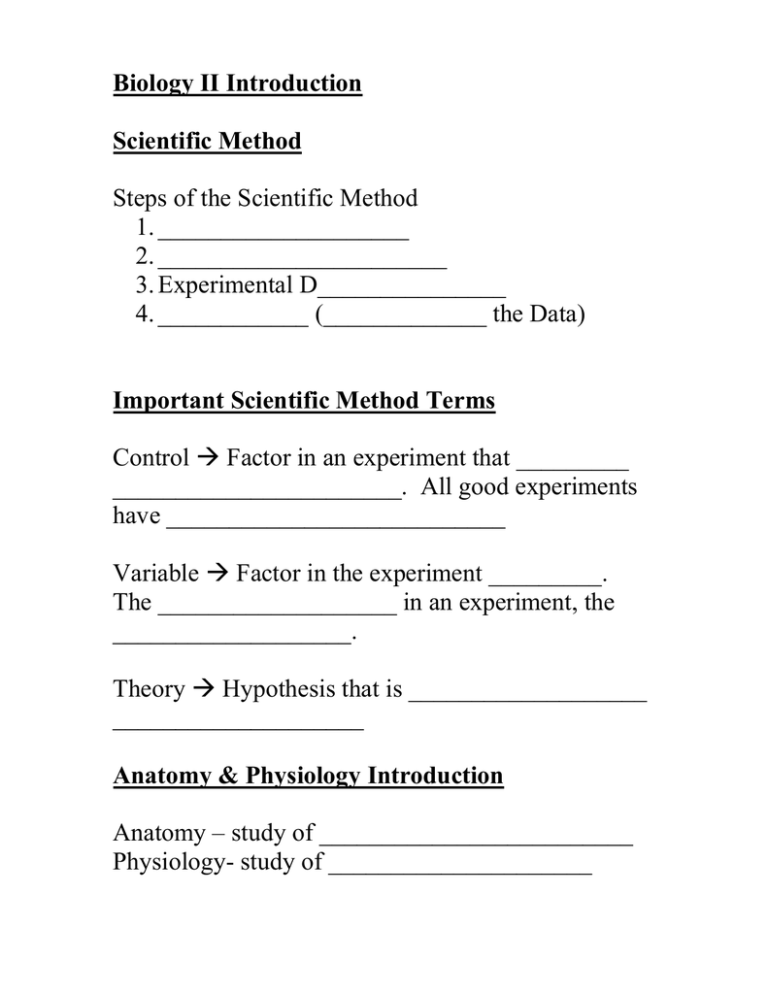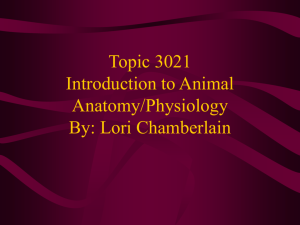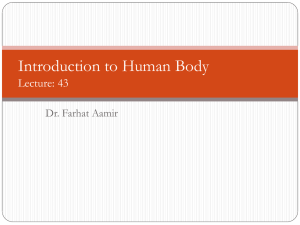Biology II Introduction Scientific Method Steps of the Scientific Method
advertisement

Biology II Introduction Scientific Method Steps of the Scientific Method 1. ____________________ 2. _______________________ 3. Experimental D_______________ 4. ____________ (_____________ the Data) Important Scientific Method Terms Control Factor in an experiment that _________ _______________________. All good experiments have ___________________________ Variable Factor in the experiment _________. The ___________________ in an experiment, the ___________________. Theory Hypothesis that is ___________________ ____________________ Anatomy & Physiology Introduction Anatomy – study of _________________________ Physiology- study of _____________________ Anatomy & Physiology are linked because ______ ____________________ Example: Heart- Ventricles of heart consist of _____________ These muscles are used expel _______________ of the rest of the body TeethMolars are ___________; used for ___________ Canines & incisors are ________; used for ________________________ Levels of Structure and Organization in the Body Level Example Characteristics of Life 1. Made of __________________ 2. ________________________________ 3. Universal __________________________ 4. Growth and _________________________ Growth- Increase in amount of ______________ in an organism Development- Series of changes an organism undergoes in ________________________ 5. Obtain & use ______________ (from food or sun) 6. Respond to their ______________________ Stimulus: anything in an organism’s environment that causes _____________________ 7. Homeostasis: Organisms maintain __________________internal conditions regardless of external changes Examples? 8. Evolve: Species ________________ over time Requirements of Organisms Water- used for _________________; ______________ of molecules, _____________of body temperature Food- provide ___________________; ___________ for building new molecules Oxygen- Used to release ________________; drives _________________ Heat- Increases the _______________________ in the body Pressure- application of a ________________; aids in _____________(atmospheric pressure) and _______________ (blood pressure) Homeostasis & Feedback Loops The stabilization of internal conditions is governed by ________________ 1. __________ = cells or parts of cells that provide _____________________________ environment 2. Control Center = usually ______ or _____. Tells the body what the internal environment __________ 3. Effectors = __________________ that _______ ____________ of the internal environment Negative Feedback Loop: _________________ ______________; ________________ registers deviation, and effectors _____________________ Example: Body _____________, ____________ & ________________ (book) Organization of the Human Body Axial Portion ________________ Appendicular Portion _______________ Body Cavities Dorsal Cavity Cranial and ________________ Ventral Cavity ______________________ and Pelvic Cavities Cavity Membranes Serous Membranes Line ____________________ organs in place Examples: Pleural Membranes Line the ____________ Pericardial Membrane Lines the _____________ Peritoneal Membrane Lines the _______________ An Introduction to the Human Body Directional Terms Superior toward the __________________________ Example: The ______________________________ Inferior Away ________________________________ Example: The ______________________________ Anterior toward the______________________; a body lying in the prone position has its ______________________. In the supine position it is _______________________ Example The ___________________________ Posterior Toward the_________________________ Example: The ____________________________ Medial Nearer to the_______________________. The midline is an ______________________________that divides the body into _____________________________ Example: The ______________________________ Lateral Farther _______________________________ Example: The ______________________________ Intermediate ___________________________ Example: Your ___________________ to your ____________________________________ Ipsilateral On the _____________________________ Example: The ______________________________ Contralateral On the _______________________ Example: The ___________________________ Proximal Nearer ______________________;_______. Example: The __________________________ Distal ___________________________________; _________________ Example: The _______________________________ Superficial Toward __________________________ Example: The _____________________________ Visceral Toward _____________________________ Example: The _______________________________ Parietal Forming the _________________________ Example The __________________________ ___________________ Sagittal Planes and Body Symmetry Anatomical terminology is ____________________the cuts or divisions within the human body Divisions of the Body Sagittal Plane _________________________into 2 parts; ___________________ Frontal Plane ________________________into 2 parts; __________________________ Transverse Plane Divides the body __________________________________ Subdivisions of Anatomy & Physiology Gross Anatomy Study of _____________________________ _____________________ Systemic Anatomy Study of _____________________ Radiographic Anatomy Study of _____________________ Developmental Anatomy Study of ___________________ Embryology Study of _________________________ Histology Study of __________ Cytology Study of ____________ Pathological Anatomy Study of ______________________ _________________________ Pathophysiology Study of __________________________ _______________________ Neurophysiology Study of the _______________________ Endocrinology Study of _______________________ Immunology Study of _____________________ Renal Physiology Study of _____________________




